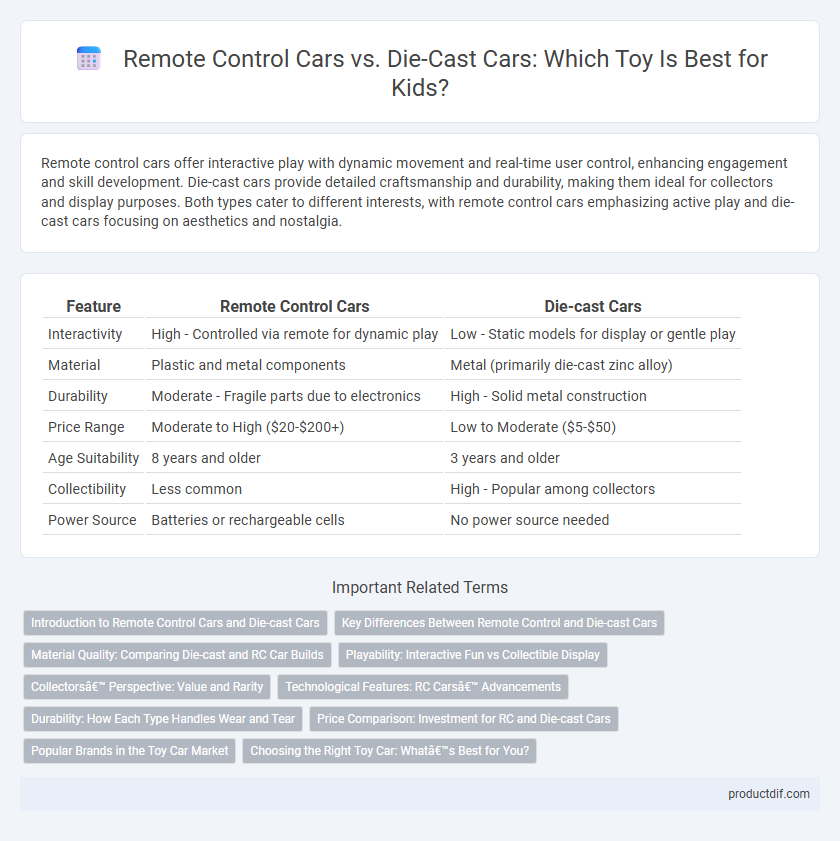Remote control cars offer interactive play with dynamic movement and real-time user control, enhancing engagement and skill development. Die-cast cars provide detailed craftsmanship and durability, making them ideal for collectors and display purposes. Both types cater to different interests, with remote control cars emphasizing active play and die-cast cars focusing on aesthetics and nostalgia.
Table of Comparison
| Feature | Remote Control Cars | Die-cast Cars |
|---|---|---|
| Interactivity | High - Controlled via remote for dynamic play | Low - Static models for display or gentle play |
| Material | Plastic and metal components | Metal (primarily die-cast zinc alloy) |
| Durability | Moderate - Fragile parts due to electronics | High - Solid metal construction |
| Price Range | Moderate to High ($20-$200+) | Low to Moderate ($5-$50) |
| Age Suitability | 8 years and older | 3 years and older |
| Collectibility | Less common | High - Popular among collectors |
| Power Source | Batteries or rechargeable cells | No power source needed |
Introduction to Remote Control Cars and Die-cast Cars
Remote control cars feature electronic components allowing users to operate the vehicle remotely via a handheld transmitter, providing interactive and dynamic play experiences. Die-cast cars are meticulously crafted from metal alloys, offering detailed and collectible miniature replicas favored by enthusiasts for display. Both types serve distinct purposes: remote control cars emphasize agility and user control, while die-cast cars highlight craftsmanship and scale realism.
Key Differences Between Remote Control and Die-cast Cars
Remote control cars feature electric motors and wireless controls, allowing for interactive driving experiences, whereas die-cast cars are static models made from metal alloys primarily designed for collecting and display. Remote control cars emphasize functionality and playability with moving parts, while die-cast cars prioritize detailed craftsmanship and realism in scale models. The materials and usage purpose distinctly separate these toys, with remote control cars suited for active engagement and die-cast cars favored by collectors.
Material Quality: Comparing Die-cast and RC Car Builds
Die-cast cars feature sturdy metal bodies made from zinc alloy, providing durability and a premium weighty feel, while remote control cars often combine plastic chassis with metal components to balance lightweight performance and structural integrity. High-quality die-cast models emphasize detailed finishes and solid construction, making them ideal for collectors, whereas remote control cars prioritize robust materials that can withstand impact during active play. Material quality in die-cast models leans toward realism and longevity in display, whereas RC cars focus on resilience and functional design for dynamic operation.
Playability: Interactive Fun vs Collectible Display
Remote control cars offer dynamic, interactive play experiences with features like responsive steering, speed control, and obstacle navigation, engaging children in active, hands-on fun. Die-cast cars primarily serve as collectible items with detailed craftsmanship and realistic designs, appealing to enthusiasts who value display quality over playability. The choice between these toys depends on whether the focus is on immersive play or aesthetic collection.
Collectors’ Perspective: Value and Rarity
Remote control cars attract collectors by offering interactive playability combined with limited edition releases, which enhances their market value and rarity over time. Die-cast cars hold significant appeal due to their detailed craftsmanship and enduring physical presence, often increasing in value as vintage models become scarce. Both types appeal to collectors through scarcity and uniqueness, but die-cast models generally command higher prices in traditional collector markets.
Technological Features: RC Cars’ Advancements
Remote control cars showcase cutting-edge technological features such as advanced radio frequency systems, rechargeable lithium-ion batteries, and precision steering mechanisms that enable superior maneuverability. Many RC cars integrate smartphone apps for customizable controls, real-time telemetry, and programmable speed settings, enhancing user engagement. In contrast, die-cast cars prioritize detailed craftsmanship and durability but lack interactive or electronic functionalities.
Durability: How Each Type Handles Wear and Tear
Remote control cars are designed with durable plastic and reinforced components to withstand impacts and rough play, offering resilience during active use. Die-cast cars feature metal bodies that resist scratches and dents better than plastic, providing long-lasting structural integrity. Both types handle wear and tear effectively, but remote control cars excel in dynamic durability, while die-cast cars maintain aesthetic durability.
Price Comparison: Investment for RC and Die-cast Cars
Remote control cars typically require a higher initial investment, ranging from $50 to over $500 depending on features, compared to die-cast cars which usually cost between $10 and $100. The ongoing costs for remote control cars include batteries, maintenance, and potential upgrades, whereas die-cast cars have minimal additional expenses, primarily limited to storage and preservation. Collectors seeking affordability often prefer die-cast models, while hobbyists investing in interactive play and customization generally choose remote control cars despite the greater financial commitment.
Popular Brands in the Toy Car Market
Hot Wheels and Maisto dominate the remote control car market with high-performance, durable models featuring advanced radio-control technology. Matchbox and Johnny Lightning lead the die-cast car segment, known for their detailed craftsmanship and authentic vehicle replicas. Brands like Traxxas blend cutting-edge RC capabilities with real-world realism, while Mattel supports both categories, expanding collectible appeal.
Choosing the Right Toy Car: What’s Best for You?
Remote control cars offer interactive play with features like speed control, maneuverability, and battery life, making them ideal for kids who enjoy hands-on activities and tech engagement. Die-cast cars provide durable, detailed models perfect for collectors and younger children who prefer realistic designs and sturdy construction without the need for batteries. Selecting the best toy car depends on the child's age, interests, and whether they prioritize playability or display value.
Remote Control Cars vs Die-cast Cars Infographic

 productdif.com
productdif.com